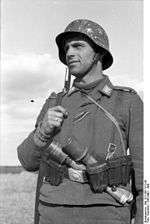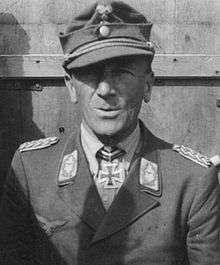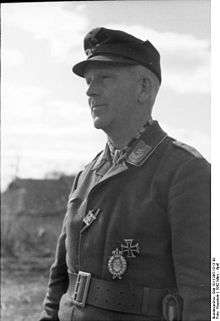Luftwaffe Field Division
The Luftwaffe Field Divisions (German: Luftwaffen-Feld-Divisionen or LwFD) were German military formations during World War II.
History

The divisions were originally authorized in October 1942, following suggestions that the German Army, the Heer, could be bolstered by transferring personnel from other services. The head of the Luftwaffe, Hermann Göring, formulated an alternative plan to raise his own infantry formations under the command of Luftwaffe officers; this was at least partly due to political differences with the Heer. Göring took great pride in the degree of political commitment and indoctrination of the air force men (he went as far as to describe the air-force paratroopers as "political soldiers") while the Army was considered (by Nazi standards) too "conservative" (linked to traditions and ideals harking back to the Imperial days of the Kaiser).

The plan was approved, and the divisions were raised from 200,000–250,000 Luftwaffe ground, support and other excess personnel. They were initially organized with two Jäger regiments of three battalions each, along with an artillery battalion and other support units, but were substantially smaller than equivalent Heer divisions, and by Göring's personal order were intended to be restricted to defensive duties in quieter sectors. Most of the units spent much of their existence on the Eastern Front: Luftwaffe Field Divisions were present at actions such as the "Little Stalingrad of the North", the attempt to relieve Velikiye Luki; the attempted defence of Vitebsk during Operation Bagration, and the fighting in the Courland Pocket, though they also fought in other theatres.
The Luftwaffe Field Divisions initially remained under Luftwaffe command, but late in 1943 those that had not already been disbanded were handed over to the Heer and were reorganized as standard infantry divisions with three two-battalion rifle regiments (retaining their numbering, but with Luftwaffe attached to distinguish them from similarly numbered divisions already existing in the Heer) and Army officers.
Until taken over by the Heer (and in many cases for some time afterwards) these units were issued with standard Luftwaffe feldblau uniforms, and being so easily identifiable were said to often be singled out by opposite forces. Their reputation as combat troops was poor, despite the high standard of Luftwaffe recruits, at least in part from being required to perform roles (ground warfare) for which they as airmen had little training. They were frequently used for rear echelon duties to free up front line troops.
Impact
Field Marshal von Manstein blamed the decline of the Wehrmacht in 1943 to the creation of these divisions. Von Manstein argued that they recruited some of the most able young men into these divisions who would have made adequate NCOs and replacements to the decimated Army divisions. in his memoirs he laters blames their lack of training and coordination to severable notable defeats.
Divisions

- 1st Luftwaffe Field Division
- 2nd Luftwaffe Field Division
- 3rd Luftwaffe Field Division
- 4th Luftwaffe Field Division
- 5th Luftwaffe Field Division
- 6th Luftwaffe Field Division
- 7th Luftwaffe Field Division
- 8th Luftwaffe Field Division
- 9th Luftwaffe Field Division
- 10th Luftwaffe Field Division
- 11th Luftwaffe Field Division
- 12th Luftwaffe Field Division
- 13th Luftwaffe Field Division
- 14th Luftwaffe Field Division
- 15th Luftwaffe Field Division
- 16th Luftwaffe Field Division
- Eventually transferred to the Heer as 16th Luftwaffe Infantry Division (later 16th Volksgrenadier Division)
- 17th Luftwaffe Field Division
- 18th Luftwaffe Field Division
- 19th Luftwaffe Field Division (later 19th Luftwaffe Sturm Division)
- Eventually transferred to the Heer as 19th Grenadier Division (later 19th Volksgrenadier Division)
- 20th Luftwaffe Field Division (later 20th Luftwaffe Sturm Division)
- 21st Luftwaffe Field Division (previously the Meindl Division, an ad hoc collection of Luftwaffe resources)
- 22nd Luftwaffe Field Division - never formed, its sub-units were assigned to other divisions.
See also
References
- Ruffner, Kevin. Luftwaffe Field Divisions, 1941–45, Osprey, 1997, ISBN 1-85532-100-9